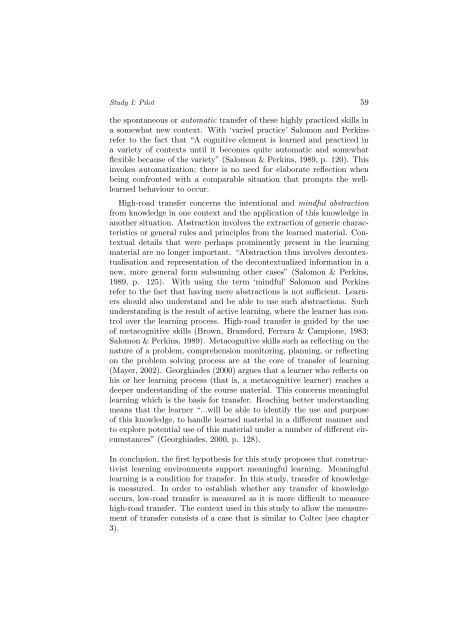The role of metacognitive skills in learning to solve problems
The role of metacognitive skills in learning to solve problems
The role of metacognitive skills in learning to solve problems
Create successful ePaper yourself
Turn your PDF publications into a flip-book with our unique Google optimized e-Paper software.
Study I: Pilot 59<br />
the spontaneous or au<strong>to</strong>matic transfer <strong>of</strong> these highly practiced <strong>skills</strong> <strong>in</strong><br />
a somewhat new context. With ‘varied practice’ Salomon and Perk<strong>in</strong>s<br />
refer <strong>to</strong> the fact that “A cognitive element is learned and practiced <strong>in</strong><br />
a variety <strong>of</strong> contexts until it becomes quite au<strong>to</strong>matic and somewhat<br />
flexible because <strong>of</strong> the variety” (Salomon & Perk<strong>in</strong>s, 1989, p. 120). This<br />
<strong>in</strong>vokes au<strong>to</strong>matization; there is no need for elaborate reflection when<br />
be<strong>in</strong>g confronted with a comparable situation that prompts the welllearned<br />
behaviour <strong>to</strong> occur.<br />
High-road transfer concerns the <strong>in</strong>tentional and m<strong>in</strong>dful abstraction<br />
from knowledge <strong>in</strong> one context and the application <strong>of</strong> this knowledge <strong>in</strong><br />
another situation. Abstraction <strong>in</strong>volves the extraction <strong>of</strong> generic characteristics<br />
or general rules and pr<strong>in</strong>ciples from the learned material. Contextual<br />
details that were perhaps prom<strong>in</strong>ently present <strong>in</strong> the learn<strong>in</strong>g<br />
material are no longer important. “Abstraction thus <strong>in</strong>volves decontextualisation<br />
and representation <strong>of</strong> the decontextualized <strong>in</strong>formation <strong>in</strong> a<br />
new, more general form subsum<strong>in</strong>g other cases” (Salomon & Perk<strong>in</strong>s,<br />
1989, p. 125). With us<strong>in</strong>g the term ‘m<strong>in</strong>dful’ Salomon and Perk<strong>in</strong>s<br />
refer <strong>to</strong> the fact that hav<strong>in</strong>g mere abstractions is not sufficient. Learners<br />
should also understand and be able <strong>to</strong> use such abstractions. Such<br />
understand<strong>in</strong>g is the result <strong>of</strong> active learn<strong>in</strong>g, where the learner has control<br />
over the learn<strong>in</strong>g process. High-road transfer is guided by the use<br />
<strong>of</strong> <strong>metacognitive</strong> <strong>skills</strong> (Brown, Bransford, Ferrara & Campione, 1983;<br />
Salomon & Perk<strong>in</strong>s, 1989). Metacognitive <strong>skills</strong> such as reflect<strong>in</strong>g on the<br />
nature <strong>of</strong> a problem, comprehension moni<strong>to</strong>r<strong>in</strong>g, plann<strong>in</strong>g, or reflect<strong>in</strong>g<br />
on the problem solv<strong>in</strong>g process are at the core <strong>of</strong> transfer <strong>of</strong> learn<strong>in</strong>g<br />
(Mayer, 2002). Georghiades (2000) argues that a learner who reflects on<br />
his or her learn<strong>in</strong>g process (that is, a <strong>metacognitive</strong> learner) reaches a<br />
deeper understand<strong>in</strong>g <strong>of</strong> the course material. This concerns mean<strong>in</strong>gful<br />
learn<strong>in</strong>g which is the basis for transfer. Reach<strong>in</strong>g better understand<strong>in</strong>g<br />
means that the learner “...will be able <strong>to</strong> identify the use and purpose<br />
<strong>of</strong> this knowledge, <strong>to</strong> handle learned material <strong>in</strong> a different manner and<br />
<strong>to</strong> explore potential use <strong>of</strong> this material under a number <strong>of</strong> different circumstances”<br />
(Georghiades, 2000, p. 128).<br />
In conclusion, the first hypothesis for this study proposes that constructivist<br />
learn<strong>in</strong>g environments support mean<strong>in</strong>gful learn<strong>in</strong>g. Mean<strong>in</strong>gful<br />
learn<strong>in</strong>g is a condition for transfer. In this study, transfer <strong>of</strong> knowledge<br />
is measured. In order <strong>to</strong> establish whether any transfer <strong>of</strong> knowledge<br />
occurs, low-road transfer is measured as it is more difficult <strong>to</strong> measure<br />
high-road transfer. <strong>The</strong> context used <strong>in</strong> this study <strong>to</strong> allow the measurement<br />
<strong>of</strong> transfer consists <strong>of</strong> a case that is similar <strong>to</strong> Coltec (see chapter<br />
3).
















